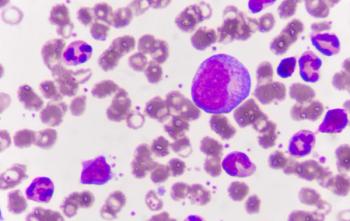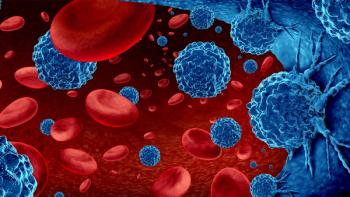
Precision Medicine Highlights the Importance of Biomarkers in Melanoma

With the identification of actionable alterations, precision medicine continues to lead the way in all areas of oncology, but especially in melanoma, according to Jason J. Luke, MD, FACP, who added that, in order to successfully apply personalized therapy, it’s critical to be fluent in the differences between biomarkers.
With the identification of actionable alterations, precision medicine continues to lead the way in all areas of oncology, but especially in melanoma, according to Jason J. Luke, MD, FACP, who added that, in order to successfully apply personalized therapy, it’s critical to be fluent in the differences between biomarkers.
“Precision medicine, especially in the field of oncology, defines the way we develop new drugs and how we select therapies for individual patients. When we think of actionable alterations, we commonly think of something such as an NTRK fusion. If we find this alteration, no matter what type of cancer the patient has, there's a drug that we can administer.”
Even so, Luke argued that clinicians should take additional factors into consideration.
“For example, in melanoma, we can profile patients based on their PD-L1 status and tumor mutational burden [TMB], along with other factors, but we don't use that information to make treatment decisions,” said Luke, an associate professor of medicine in the Division of Hematology/Oncology at University of Pittsburgh Medical Center Hillman Cancer Center. “Rather, this information is used to predict the response to treatment.”
In an interview with Oncology Nursing News' sister publication, OncLive, during an 2020 Institutional Perspectives in Cancer webinar on precision medicine, Luke, who is also the director of the Cancer Immunotherapeutics Center Immunology and Immunotherapy Program, highlighted the importance of precision medicine in melanoma, along with diving deeper into differences between biomarkers.
OncLive®: What clinical impact do these varying biomarkers in melanoma have?
Luke: The concept of biomarkers is important. Prognostic biomarkers tell us how well the patient’s disease is going to do over time. This is opposed to a predictive biomarker, which is usually linked to a therapeutic approach that may be beneficial to the patient. We can give a couple of examples of these that are similar but different.
When we profile tumors, we can sometimes find BRAF mutations in melanoma or colon cancer, or an EGFRmutation in lung cancer. It's quite interesting that both of these markers are prognostic and predictive, but very different. BRAF mutations in melanoma predict a poor prognosis but are also predictive of the treatment effect of a BRAF inhibitor. In lung cancer, an EGFR mutation is predictive of a better prognosis, as well as the effect of an EGFR inhibitor. It’s important to be cognizant of the differences. Doing so can be useful when we think about how we can apply these biomarkers to other patients.
There are also integral and integrated or complementary biomarkers. In clinical trials, there will often be a selection feature, meaning a factor that is necessary for enrollment. This is an example of an integral marker.
An integrated marker would be something that we're interested in, as it relates to the treatment. For example, PD-L1 can function asboth in different settings. In lung cancer, treatment with PD-L1 inhibitors is dictated by an integral marker; therefore, the patient must express high levels of PD-L1 to receive them.
The complementary status is useful in other diseases, such as bladder cancer and melanoma, where it might inform treatment decisions. Understanding the distinction between these categories of biomarkers is useful as you approach applying molecular therapies to patients in practice.
How have some targeted agents changed how you approach treatment for patients with melanoma?
In metastatic melanoma, we apply genomic profiling to better understand which therapeutic strategies might be optimal. We split melanoma into 4 molecular categories: BRAF mutant, which is about 50% of melanomas, RAS mutant—particularly NRAS mutant—which is about 25% of patients with melanoma, and NF1 mutant, which consists of about 15% of patients. Moreover, there is the triple wild-type group, which includes KIT mutations, HER2 amplification, and a number of other much rarer molecular aberrations.
Now, in terms of FDA-approved therapies, only BRAF is targetable per an FDA label, with BRAF and MEK inhibitors. However, there are a number of other aberrations that can be targeted, such as KIT, which includes c-KIT mutations, and also HER2 amplification.
New strategies in development in clinical trials are attempting to explore targeted therapies in NRAS- andNF1-mutant tumors with MEK and ERK inhibitors, either alone or in combination with targeted therapies, such as CDK inhibitors. Right now, there is a lot of action around BRAF, although, as we continue to watch this space, we hope to see additional targetable alterations in the near future.
Why is molecular testing so important in this space?
As a standard in the field of oncology, we should integrate molecular testing to help drive therapeutic options. With that said, we conduct phase 3 trials and rely on robust evidence for a reason. The treatment of patients should really follow standard algorithms; however, having a sense of the molecular status is also important when standard therapeutic options are not immediately obvious.
Now, that isn't to say that we should just order molecular testing; rather, we should have a hypothesis of what we are looking for. For example, in melanoma, we don't always order next-generation sequencing [NGS] immediately because we're commonly looking for BRAF mutations. However, if there aren’t any BRAFmutations, NGS is very useful because there are rare variants that could be targeted, such as NTRK and HER2 amplification. A similar story is present in other tumors as well.
I’m also interested in cholangiocarcinoma, which is commonly treated with chemotherapy, followed by referral to early-phase clinical trials thereafter. However, there's a wealth of genomic targets that are harbored by patients with these tumors, including IDH and BRAF mutations, along with others, which can be identified with molecular testing.
Please expand on the thought process to “treat patients, not biomarkers.”
We must think about how biomarker information can inform appropriate treatment decisions for patients. With this said, we should not treat biomarkers; we should treat patients.
The most obvious example of this is the recent FDA approval of pembrolizumab [Keytruda], a PD-1 inhibitor, in tumors with high TMB. The cutoff for this was 10 mutations per megabase, which I believe is a helpful consideration for some patients. The majority of patients with TMB greater than 10 mutations per megabase are going to be those with common gastrointestinal cancers, such as colon cancer and sometimes pancreatic cancer. It’s been very well established that these patients do not respond to anti—PD-1 therapies; thus, they should not be used in practice. Despite the fact that there is an approval in this setting, understanding where the biomarker is relevant is of critical importance.
Where should research efforts in melanoma space focus on next?
In terms of next-generation targeted therapies, we're all waiting for the next therapeutic target, something similar to BRAF and NTRK. There are a number in early stages of development, but we haven't discovered the next actionable alteration yet.
Now, from deep molecular sequencing, we’re starting to realize that there are rare variants, and we must sort out how to find these patients. In other words, if there is a mutation, but it's only present 1% of patients, how do we find them and ensure they receive the appropriate course of therapy?
Newsletter
Knowledge is power. Don’t miss the most recent breakthroughs in cancer care.

















































































